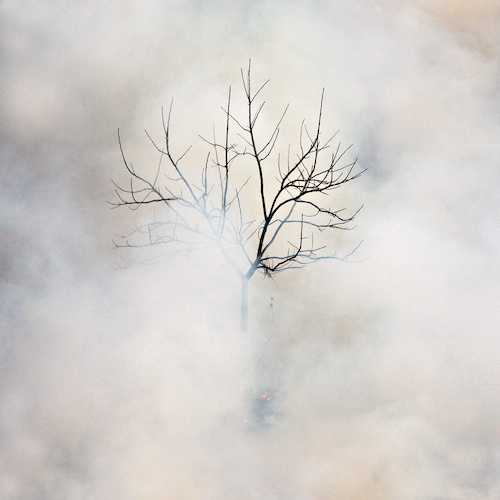The Burn
Jane Fulton Alt
Kehrer Verlag, 2013
Reviewed by Leo Hsu
At the beginning of Jane Fulton Alt’s The Burn, we see trees surrounded by and disappearing in smoke. The first photograph is of a lone tree, its dark branches contrasting markedly with the clouds of smoke enveloping it. This picture is followed by one of a stand of smaller trees, the smoke gathering over the ground around them.
As the sequence proceeds, figure and ground invert; we are no longer looking at trees in the smoke, but at the smoke itself. By the time fire erupts, about halfway through the book, the inversion of subject and context has been clearly established. Alt’s pictures do not describe what things look like as they burn, they explore the process of burning. The atmosphere is in constant, rolling motion, branches exploding and flames blossoming: not still life, but the motion of dying things propelled by their own consumption. The trees and brush that are destroyed in the controlled burns are the fuel that makes these subjects visible. As Deborah Gribbon writes in one of the essays that complement Alt’s pictures so well, “the transformative power of smoke and fire is the real subject of these images”.
Plate 1 © Jane Fulton Alt
Previous to photographing controlled burns, Alt’s subjects were births, and then the end of life and the preparation of the body after death. When her grandchild was born at the same time that her sister was diagnosed with cancer, Alt embarked on the photography of controlled burns, a subject that was continuous with her interest in cremation practices, and the cycles of life and death. Controlled burns help maintain native ecosystems, the ash enriching the soil. Some plants require the high heat of fire to germinate. Alt photographed these burns, not as a study of practical fire ecology, but for the opportunity to explore, as she writes, “the ephemeral moment when life and death are not opposed but are harmonized as a single process to be embraced as one”.
Plate 19 © Jane Fulton Alt
The resulting book is a poetic and finely sequenced flow of images that invites contemplation of the relationship between destruction and regeneration, and of how the visible forms of destruction- the seductive beauty and terrifying force of smoke, ash and fire – create access to a broader understanding of life and death as a course of transformation.
The project is well conceived and well executed. Alt photographed controlled burns in Lake Forest, Illinois twice each year – the burnings take place in the spring and the fall – over six years, and the intimacy of the photographs is surely a result of that extended investment of time. The pictures individually are engaging and move in and out of specificity. Intangible smoke, flame and ash are tactilely invoked. For the most part the pictures themselves are not flamboyant, but measured, though sometimes they barely contain explosive violence. The small format of the volume makes this a photobook to be read and absorbed as a whole.
J.M.W. Turner, Rain, Steam and Speed – The Great Western Railway (1844)
Gribbon likens Alt’s photographs to the late 18th and early 19th century Romantic paintings of J.M.W. Turner, in whose work violent storms and turbulent seas show nature’s strength and ferocity. Michael Weinstein’s essay similarly invokes the Romantic sublime, noting that Alt’s photographs invite us to inspect scenes of astonishing danger and power in safety: “There is too much power in Alt’s images to take them lightly or as a diversion. The images are exquisite, yet because of that they deliver an enhanced aesthetic and psychological impact”. In the context of industrial modernization, the sublime presented both a reminder of the scale of nature’s power over human attempts to harness it, and an acknowledgment of the terrible force of industrial inventions, as embodied by the train in Turner’s Rain, Steam and Speed – The Great Western Railway (1844).
Plate 26 © Jane Fulton Alt
The Burn is a similar reminder for the early 21st century, a response to this moment in modernity, a caution against vanities. Our own burns are not, of course, so controlled, despite our best efforts, and it can be hard, in our every day lives, to take the long view. Alt’s photographs address basic questions about the nature of mortality, and of existence, but they eschew doctrine and discourse, and they bypass rationality, explanations, religions, conclusions.
Leo Hsu is a photographer, writer and photography instructor, based in Pittsburgh, PA.
Contact Leo here.
Support Fraction and buy the book here.





